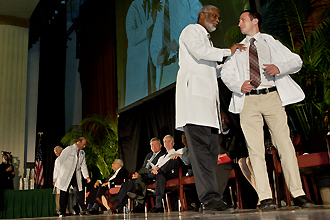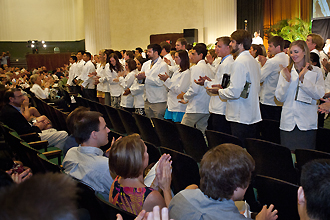Med Students Launch Careers at White Coat Ceremony
In a tradition-filled ceremony, 190 new students of Tulane University School of Medicine received their first white coats on Sunday (July 31) in McAlister Auditorium. They plunged immediately into their studies, with classes that began on Monday (Aug. 1).

Dr. Ernest Sneed, assistant dean of student affairs, places a white coat on the shoulders of incoming medical student Jonathan Sachs. (Photos by Paula Burch-Celentano)

After receiving their white jackets, the symbol of entering the physician's profession, the members of the first-year medical class turn around to applaud their families.
“The white coat ceremony is the introduction for medical students into the medical profession,” says Dr. Marc J. Kahn, senior associate dean for admissions and student affairs. “At this event they get a stethoscope, which is a symbol of medicine and a tool used in medicine; they get their white coats, also a symbol of the medical profession; and they are for the first time making an oath as a physician. It's a really exciting day for students, parents and their families.”
Dr. James R. Doty, a 1981 Tulane medical school graduate and eminent neurosurgeon, entrepreneur and philanthropist, delivered the annual Dr. Wallace K. Tomlinson Lecture, and Dr. Hyman C. Tolmas, a 1945 medical school graduate, gave the distinguished alumnus address.
Dr. Ernest J. Sneed, assistant dean of student affairs, placed a white coat on the shoulders of each new student. Afterward, they received their first stethoscopes, gifts from the Tulane Medical Alumni Association. Each student also was given a Tulane emblem patch for their coats, as well as a “Humanism in Medicine” pin from the Arnold P. Gold Foundation.
This year's crop of 190 incoming students was chosen from among 10,210 applicants up from 10,038 last year. Ninety-five different universities and colleges are represented. Sixteen hail from Tulane, two each from the University of New Orleans and Louisiana State University, and one from Xavier University of Louisiana. Thirty-six states and three countries (Uruguay, Bahamas and Nigeria) are represented in this class. Louisiana and California are the states that contributed the most students, with 28 each.
The careers most in demand among this class of students are in pediatrics, family medicine, surgery, orthopedics, emergency medicine, primary care and neurology.
